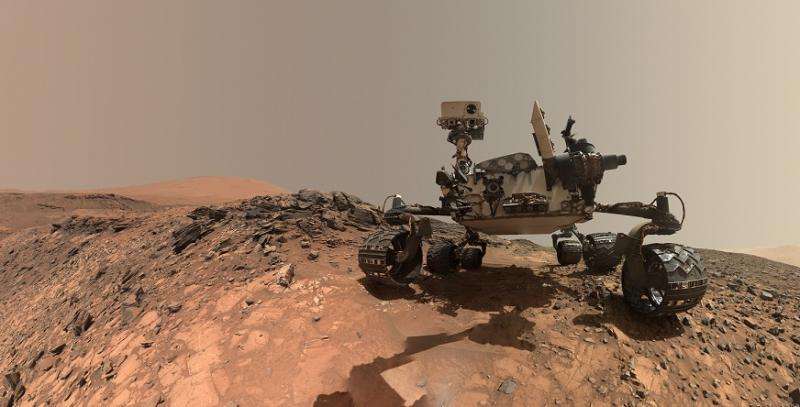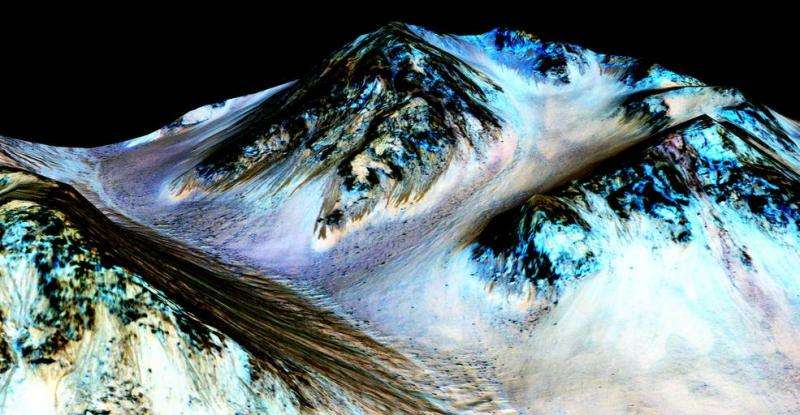Mars rover scientist hopes to find more evidence of liquid water

Although the existence of liquid water on the Red Planet was confirmed by NASA's Mars Reconnaissance Orbiter (MRO) last year, the scientific community is gearing up for a more thorough analysis of the topic that could be provided by the Curiosity rover, studying the Martian surface in-situ. Raina Gough of the University of Colorado Boulder, a chemist in the Curiosity rover's research team, hopes to discover more evidence of liquid water by investigating chemical processes like deliquescence, found to occur also on Mars.
Deliquescence is a process in which salts absorb water vapor from the atmosphere and form a liquid solution. This could create briny liquids under conditions likely to exist, in certain times and places, on Mars' surface.
"I will be performing laboratory experiments in which I study the deliquescence, as well as the reverse process, recrystallization, under low temperatures. This will allow the determination of the conditions under which water on Mars may exist in the liquid brine phase," Gough told Astrowatch.net.
A particle deliquesces by absorbing water vapor from the atmosphere when a threshold relative humidity value is reached. This deliquescence relative humidity (DRH) varies with salt composition as well as temperature. The reverse process, the recrystallization of a salt solution into the solid phase, is called efflorescence and occurs at the efflorescence relative humidity (ERH).
The scientists will us a laser-based microscopic device called the 'Raman microscope' to determine the DRH and ERH values of Mars relevant salts and salt mixtures under a range of low temperature conditions. As Gough noted, knowledge of these values is necessary to predict when and where aqueous salt solutions could exist on the surface of Mars.

"In combination with the Rover Environmental Monitoring Station (REMS) data, this may enable prediction of when and where a brine may exist at the landing site. This information can be utilized to guide the Dynamic Albedo of Neutrons (DAN), Sample Analysis at Mars (SAM) and maybe ChemCam analytical strategies to possibly detect or constrain the presence and duration of small amounts of liquid water in Gale Crater," Gough said.
REMS instrument onboard Curiosity provides daily and seasonal reports on atmospheric pressure, humidity, ultraviolet radiation at the Martian surface, wind speed and direction, air temperature, and ground temperature around the rover. DAN is a pulsing neutron generator sensitive enough to detect water content as low as one-tenth of one percent and resolve layers of water and ice beneath the surface. SAM is capable of detecting organic compounds like methane and also light elements, such as hydrogen, oxygen, and nitrogen, associated with life. These instruments are complemented by ChemCam that fires a laser and analyzes the elemental composition of vaporized materials - recognizing ice and minerals with water molecules in their crystal structures.
Gough will try to determine how the salts present on Mars and at Gale Crater in particular may facilitate the formation and stability of liquid brines due to deliquescence.
"Perchlorate salts are very deliquescent, even at low temperatures! The amount of liquid water formed may be small, because there is not very much water vapor in the atmosphere, but the presence of any liquid water would be very interesting for many reasons and applications like habitability, understanding the hydrological cycle and maybe even human exploration," Gough explained.
Perchlorates have previously been seen on Mars. NASA's Phoenix lander and Curiosity rover both found them in the planet's soil, and some scientists believe that the Viking missions in the 1970s measured signatures of these salts. The study of Martian downhill flows, known as recurring slope lineae (RSL) was conducted in 2015. It detected perchlorates, in hydrated form, in different areas than those explored by the landers. This was also the first time perchlorates have been identified from orbit. Now the scientists hope for new findings from the instruments on the ground.
Provided by Astrowatch.net





















